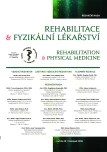Deficiencies in Physiotherapeutic Care in Context of the Children‘s Musculoskeletal System Injury of Girls Who Engage an Elite Level in Gymnastic Sports (Aerobics, Artistic or Rhythmic Gymnastics)
Authors:
K. Hassmannová; T. Nováková; L. Satrapová; D. Pavlů
Authors‘ workplace:
Katedra fyzioterapie, Fakulta tělesné výchovy a sportu, Univerzita Karlova, Praha, vedoucí katedry PhDr. T. Nováková, Ph. D.
Published in:
Rehabil. fyz. Lék., 25, 2018, No. 4, pp. 165-170.
Category:
Original Papers
Overview
Background:
he main objective was to detect the occurrence of problems of the musculoskeletal system in the form of a painful conditions and injuries among girls of elementary school age who engage in gymnastic sports at an elite level. Another objective was to find out which part of the musculoskeletal system were most prone to injury and if and to what extent does the development of pain or the occurrence of an injury effect the performance level of the gymnasts was also constituent of the objectives as well as how is the started issue addressed from the aspect of physical therapy.
Methods:
For the obtainment of data the combination of quality and quantity research was employed, in the form of a structured interview and a questionnaire. The collection of data was devised retrospectively. The research population comprised of 58 girls (average age 13.5 years) who engage in gymnastic sports at an elite level.
Results:
A problem with the musculoskeletal system occurred with 98 % of gymnasts during the time of their elementary age. The most susceptible area of the musculoskeletal system turned out to be the lower limbs, specifically knees and ankles. Situations, in which the combination of multiple problems of the musculoskeletal system occurred were more common, then the occurrence of a sole problem. In the correlation with the performance level, gymnasts placing at non-medal positions had a higher percentage of pain occurrence and injuries. The statistical analysis indicated that the occurrence of injuries of non-medal gymnasts is always higher than that of the medal gymnasts. Physical therapy prevention, whether primary or secondary, was practiced among a minimum of the gymnasts.
Conclusion:
The results of this study show a high susceptibility to painful conditions and injuries in elite-level gymnasts at younger school age and, unfortunately, confirm that primary or secondary prevention of locomotor disorders is not satisfactory at an elite level gymnast.
Keywords
musculoskeletal system, pain and injuries, physiotherapeutic prevention, hypermobility
Sources
1. BALYI, I., STAFFORD, I.: Coaching for long-term athlete development. leeds: Coachwise UK, 2005.
2. BRADSHAW, E. J.: Performance and health concepts in artistic gymnastics. International Symposium on Biomechanics in Sports: Conference Proceedings Archive, 28, 2010, s. 51-55.
2. CAINE, O. J. et al.: An epidemiologic investigation of injuries affecting young competitive female gymnasts. American Journal of Sports Medicíně, 17, 1989, 6, s. 811-820.
4. GOODWAY, J. et al.: The distribution of injuries among young female gymnasts in relation to selected training and environmental factors. Abstract. Paediatric Work Physiology, Symposium, Leuven, 1989.
5. GRABARA, M.: Postural variables in girls practicing sport gymnastics. Biomedical Human Kinetice, 2010, 2, s. 74-77.
6. KARANTANAS, A. H.: Sports injuries in children and adolescents. New York, Springer, 2010. ISBN 978-3-540-88589-4.
7. KELLER, M. S.: Gymnastics injuries and imaging in children. Pediatric Radiology, 39, 2009, 12), s. 1299.
8. KIRIALANIS, P., MALLIOU, P., BENEKA, A., GIANNAKOPOULOS, K.: Occurrence of acute lower limb injuries in artistic gymnasts in relation to event and exercise phase. British Journal of Sports Medicíně, 37, 2003, 2, s. 137-139.
9. KOLAR, E., PAVLETIČ, M. S., SMRDU, M., ATIKOVIČ, A.: Athletes’ perception of the causes of injury in gymnastics. The Journal of Sports Medicine and Physical Fitness, 57, 2017, 5, s, 703-710. DOI: 10.23736/S0022-4707.16.06228-9.
10. KUČERA, M., KOLÁŘ, P., DYLEVSKÝ, I.: Dítě, sport a zdraví. Praha, Galén, 2011. ISBN 978-80-7262-712-7.
11. LOWRY, C. B., LEVEAU, B. F. A.: Retrospective study of gymnastic inju - ries to competitors and noncompetitors in private clubs. American Journal of Sports Medicíně, 10, 1982, 4, s. 237-239.
12. MEEUSEN, R., BORMS, J.: Gymnastic Injuries. Sports Medicine. 13, 1992, 5, s. 337-356.
13. PETTRONE, F. A., RICCIARDELLI, E.: Gymnastic injuries: the Virginia experience 1982-1983. American Journal of Sports Medicíně, 15, 1987, 1, s. 59-62.
14. SANDS, W. A.: Injury prevention in women‘s gymnastics. Sports Medicine. 30, 2000,5, s. 359-373.
15. SATRAPOVÁ, L., NOVÁKOVÁ, T.: Hypermobilita ve sportu. Rehabilitace a fyzikální lékařství, 19, 2012, 4, 199-202.
16. STOŠIĆ, D., MILENKOVIĆ, S., ŽIVKOVIĆ, D.: The influence of sport on the devolopment of postural disorders in athletes. Facta Universitatis, 9, 2011, 4, s. 375-384.
Labels
Physiotherapist, university degree Rehabilitation Sports medicineArticle was published in
Rehabilitation & Physical Medicine

2018 Issue 4
Most read in this issue
- Mirror Therapy and Its Application in Neurorehabilitation
- Assessment of Sensory Processing Disorders in Children
- Influence of Breathing on Activity of Pelvic Floor Muscles in Relation to Body Position
- Physiotherapy – a Modern and Dynamic Banch
